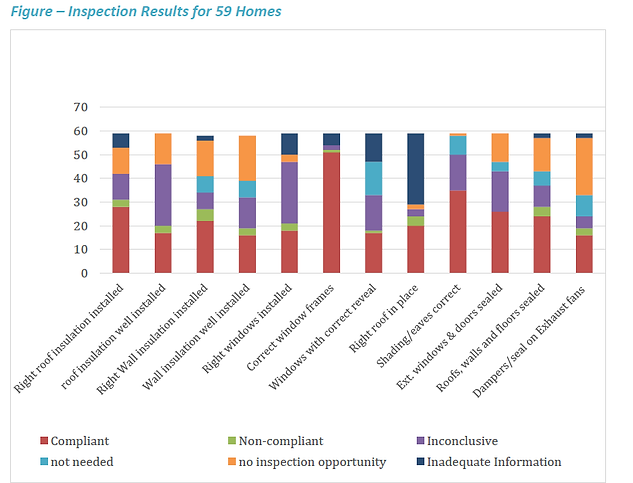Pilot Findings - A Summary
The ‘New Home Energy Efficiency Compliance Inspection Pilot’ was a significant step in working with Authorities to inform the development of compliance assessment resources. The results of the 86 inspections provide quantitative evidence of the feasibility of inspecting different National Construction Code (NCC) provisions across different house types in a variety of jurisdictional settings. Through the Pilot, participating Councils also provided important qualitative feedback on options for improving construction energy efficiency compliance in Australia. The material findings of the Pilot research are summarised in the following Sections.
The Value of ‘As Built’ Inspections
Councils recognised the benefits of assessing ‘as built’ energy efficiency compliance for promoting quality, sustainable buildings in their regions. The importance of promoting accountable industry performance with the NCC and protecting new home consumers were key drivers for Council involvement. The Pilot inspection process facilitated awareness of the NCC energy efficiency provisions for Council Officers as well as the builders who were assessed. The Pilot highlighted the opportunity for Council Sustainability/Environmental Management staff and Building Surveyors to work collaboratively in promoting energy efficiency performance for residential construction.
Determining Compliance
The Pilot program highlighted the necessity of an integrated approach to driving NCC compliance, from the design through to the approval and construction stages of residential development. Through the Pilot inspections across 59 homes, compliance was noted against various checklist parameters although the limitations reported by Council Officers, such as lack of detail in documentation flowing from approval processes and energy assessments, made accurate on-site assessment difficult. Compliance varied depending on the jurisdiction. For example, in the City of Launceston a high level of compliance was found across all checklist elements. Early inspections often provided opportunity for the Council Officer to liaise with the Builder regarding issues identified. Issues rectified between inspections were not necessarily deemed as non-compliant. Identified areas of non-compliance included:
-
Roof colour not as specified.
-
Insulation not as specified.
-
Insulation not included under flooring (where specified).
-
Insulation not installed in accordance with the NCC.
-
Alternate lighting installed by owner not as specified.
-
Glazing not as specified.
-
Inadequate sealing of glass/windows.
A variety of Building Surveyor inspection responses suggested areas yet to be completed or unable to be visually assessed. This led to a significant number of inspection elements rated by Surveyors as “inconclusive” rather than a confident assessment of compliance or non-compliance being determined. The qualitative feedback during the Pilot period and through the post-Pilot evaluation, highlighted the various system elements needed to enable verification of compliance and to support an ‘as built’ inspection regime, such as:
Provision and access to verification documentation
Inspection limitations need to be addressed where possible through verification documentation such as: insulation/window certificates and purchase details; photographic evidence from builders etc. and captured as part of the Electronic Building Passport.
Appropriate timing of inspections
The other common issue raised was the difficulty of timing inspections to be able to visually inspect certain items, mainly roof insulation, glazing type and wall insulation (it is either too late or too early to observe before linings). Whilst it was acknowledged that the NCC energy efficiency provisions require assessment at various stages of the construction cycle, it was highlighted that Councils do not have the resource capacity for site inspections beyond those mandated in each jurisdiction.
Adequate information from the approval and energy assessment stage
In many areas, compliance could not be measured due to lack of information provided in the development approval documentation with the most common areas including: roof colour not specified, lighting type not specified, air conditioning not specified and hot water not specified. This demonstrates a lack of information at building approval stage to fully reflect the basis on which the building has been considered compliant with the energy efficiency requirements of the NCC.
Factoring for performance improvements
In some cases improvements in construction and resultant energy efficiency were noted, but there appeared to be no way of estimating the impact of the improvements or offsetting the benefits against items of non-compliance.
It was stressed by participating Councils that an on-site inspection regime needs to be supported through:
-
Improved design assessment and documentation.
-
Verification of product performance through documentation.
-
Professional development and training for Building Surveyors.
One of the graphs from the executive summary appears below. For full details of the pilot findings download the final project report at this link.


